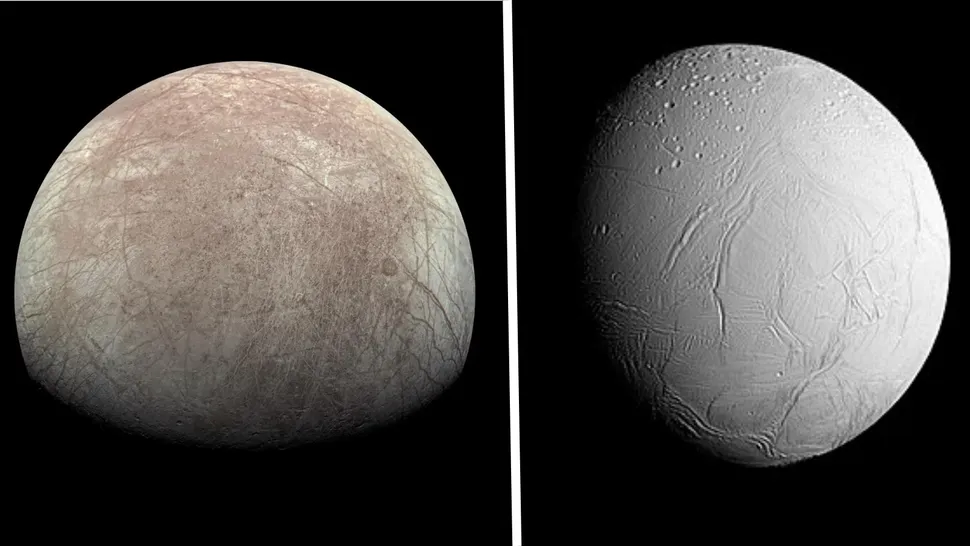Recent research suggests that signs of life may endure just beneath the frozen surfaces of Saturn’s moon Enceladus and Jupiter’s moon Europa, despite harsh radiation from the sun. Both moons are believed to harbor vast liquid water oceans beneath their icy crusts, potentially fostering conditions suitable for life.
Life Potential Below the Surface
Enceladus and Europa have long fascinated scientists due to their hypothesized subsurface oceans. These environments, shielded from solar radiation by thick ice layers, could protect complex organic molecules such as amino acids and nucleic acids — crucial components of life — which could act as “biosignatures” if detected.

Radiation Challenges and New Insights
While the moons face intense radiation from the sun and other cosmic sources, recent studies indicate that biosignatures might persist within their icy shells, protected by the thick layers of ice. This intriguing possibility has been supported by research led by Alexander Pavlov of NASA’s Goddard Space Flight Center. Pavlov’s team conducted experiments simulating the harsh conditions of Enceladus and Europa, discovering that amino acids, fundamental building blocks of life, could indeed survive just beneath the surface of Enceladus. These findings suggest that minimal digging, possibly only a few inches, would be required to retrieve these crucial molecules, making the search for life more feasible than previously thought. On Europa, the situation is equally promising. Similar molecules could potentially be retrieved from depths of up to 8 inches in regions less affected by surface disturbances. This relatively shallow depth means that future missions equipped with advanced sampling tools could explore these moons’ surfaces more efficiently, increasing the chances of detecting signs of life. The research underscores the resilience of potential biosignatures in extreme environments and highlights the importance of targeted exploration strategies in our quest to uncover life beyond Earth.
Mission Implications
Future missions to these moons could capitalize on this research, potentially using orbiting spacecraft to capture erupting plumes of biosignatures from Enceladus’ surface without requiring direct contact. This approach could streamline efforts to detect signs of life.
Habitability Below the Surface
Despite harsh surface conditions — including frigid temperatures and relentless bombardment by cosmic rays — the subsurface oceans of Enceladus and Europa offer a more hospitable environment for potential life. The surfaces of these moons are incredibly inhospitable, with temperatures plummeting to extremely low levels and high-energy particles constantly impacting them. However, beneath these icy exteriors lies a different world. The subsurface oceans, hidden beneath thick ice crusts, are warmed by tidal forces generated by the gravitational interactions with their parent planets, Saturn and Jupiter. These tidal forces create frictional heating, which prevents the oceans from freezing solid and maintains them in a liquid state.
This subsurface environment could be rich in the necessary chemistry for life. The constant movement of water beneath the ice may facilitate the mixing of minerals and nutrients, creating a dynamic and potentially life-supporting habitat. Hydrothermal vents on the ocean floors, similar to those found in Earth’s oceans, could provide energy sources through chemical reactions, supporting microbial life. These vents, where water heated by the moon’s interior interacts with the ocean, could release vital nutrients and create localized hotspots of biological activity. The combination of liquid water, essential chemicals, and energy sources forms a compelling case for the habitability of these subsurface oceans.
Furthermore, the thick ice layers act as a shield, protecting the oceans from harmful radiation and creating a stable environment where life could potentially thrive. This protective barrier allows for a more consistent and less variable environment, unlike the harsh and fluctuating conditions on the surface. The possibility of life existing in such an environment is intriguing and has significant implications for our understanding of life’s potential beyond Earth. The study of these moons and their subsurface oceans continues to be a major focus of astrobiological research, driving future missions aimed at uncovering the mysteries beneath their icy shells.
Research Advances and Future Prospects
Pavlov’s team tested amino acids under simulated moon conditions, finding that certain conditions, such as exposure to silica-rich regions or meteorite dust, could affect their survival. These findings underscore the complexity of detecting and interpreting biosignatures but also highlight potential strategies for future exploration.
Conclusion
As exploration continues, understanding the survivability of biosignatures on Enceladus and Europa remains crucial. Advances in research provide optimism that future missions could uncover compelling evidence of life beyond Earth within our own solar system.








